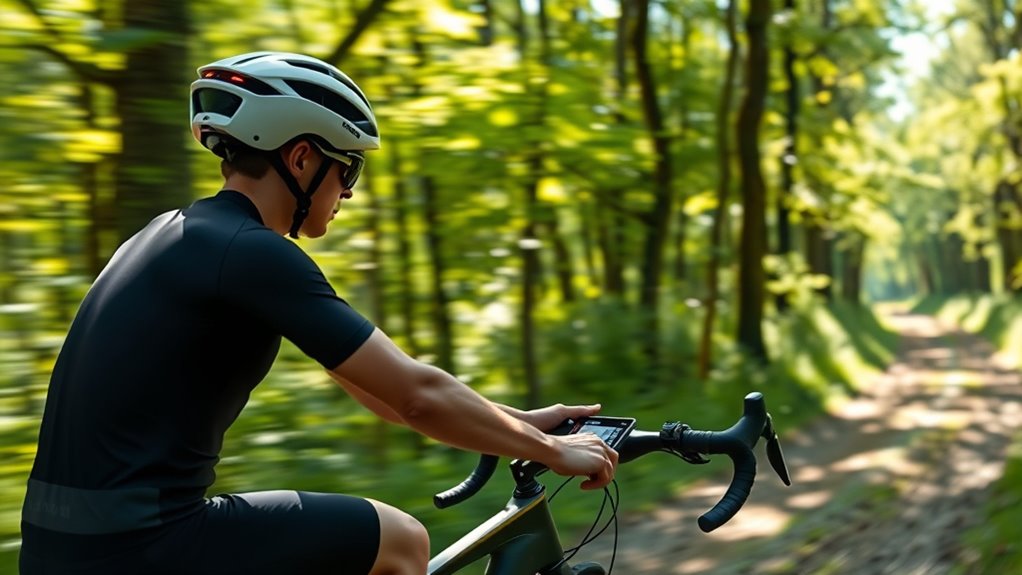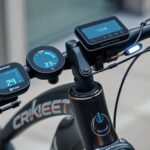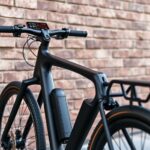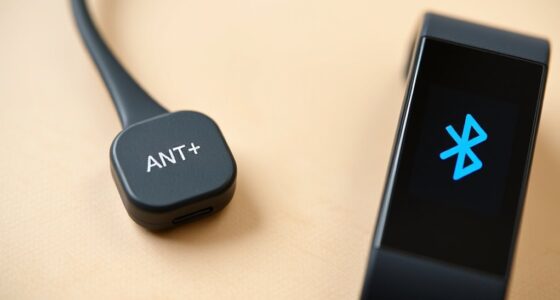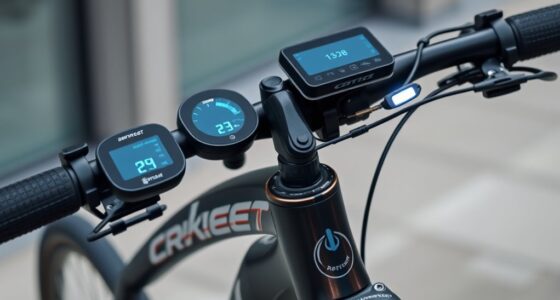By integrating smart devices like helmets with impact sensors, GPS bike computers, and intelligent lighting, you can boost your cycling safety and performance. Smart locks and environment sensors offer security and awareness, while fitness trackers help monitor your health. Seamless connectivity and customization guarantee your gear adapts to your needs. Exploring these innovations can transform your riding experience—stick around, and you’ll discover even more ways to enhance your rides.
Key Takeaways
- Incorporate smart helmets with impact sensors, LED lights, and Bluetooth to enhance safety, visibility, and communication during rides.
- Use GPS bike computers and wearable fitness trackers to monitor performance metrics like speed, heart rate, and cadence.
- Connect devices via Bluetooth, Wi-Fi, and ANT+ for seamless data sharing and real-time ride analysis across your digital ecosystem.
- Customize safety features such as smart lighting, turn signals, and crash alerts to improve visibility and rider safety.
- Regularly update firmware and calibrate sensors to maintain accuracy, optimize performance, and ensure compatibility with your cycling setup.
Exploring the Latest Smart Devices for Cyclists
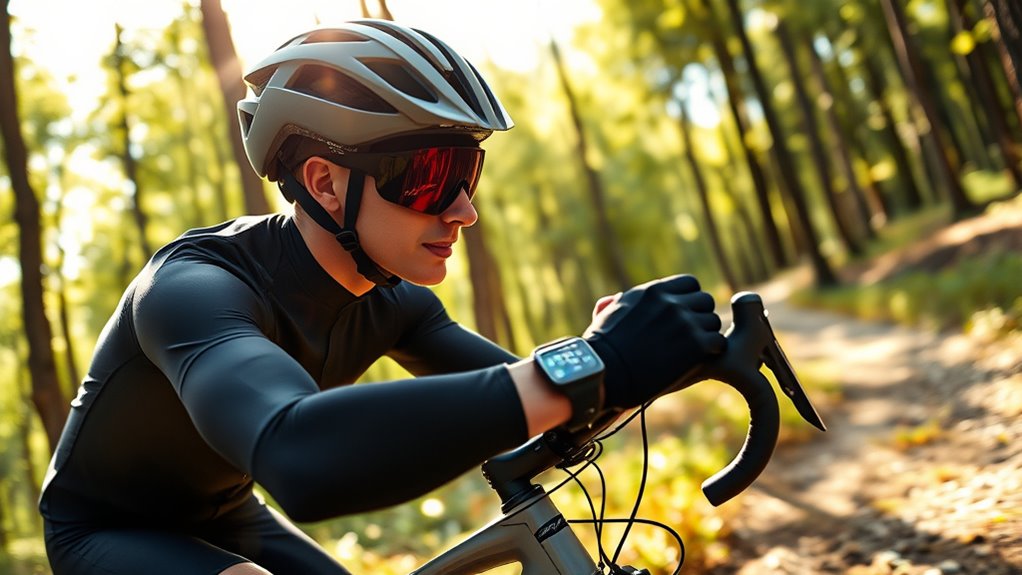
Are you curious about the newest smart devices that can elevate your cycling experience? Today’s cycling technology offers a range of innovative options, from GPS bike computers like Garmin Edge and Wahoo ELEMNT to smart helmets that combine LED lights, cameras, and impact sensors. These devices enhance safety and connectivity, providing real-time data on your ride and safety features for peace of mind. Smart lights with automatic brightness and turn signals boost visibility, especially in low-light conditions. Wearable fitness trackers like Fitbit or Apple Watch track performance metrics such as heart rate, calories, and sleep, helping you optimize your training. Smart sensors, including tire pressure monitors, deliver real-time data to maintain ideal performance and prevent issues, making your ride safer and more efficient. Additionally, integrating high contrast ratio projectors into your setup can improve visibility and image quality during outdoor activities or indoor training sessions.
Choosing the Right Performance Tracking Tools

Choosing the right performance tracking tools means selecting devices that provide accurate data tailored to your riding style. Make sure they easily sync with your favorite apps like Strava or Garmin Connect for seamless analysis. Prioritize durability and battery life to keep your data consistent during all your rides. Incorporating sensor calibration ensures your measurements remain precise over time. Additionally, considering data-driven strategies can help you identify areas for improvement and optimize your performance. Using wireless technology can simplify setup and reduce cable clutter during your rides. Utilizing professional voice actors in instructional materials can also enhance clarity and learner engagement. Investing in vetted home theatre projectors can also enhance your training environment by providing clear visuals for instructional videos or virtual coaching sessions.
Selecting Accurate Devices
Selecting the right performance tracking tools is essential for accurately monitoring your cycling progress. Focus on devices that deliver precise performance metrics like speed, distance, cadence, and power. GPS cycling computers such as Garmin Edge or Wahoo ELEMNT are excellent choices, providing detailed data for every ride. Look for fitness trackers like Apple Watch or Fitbit for reliable heart rate monitoring and calorie tracking. Verify your devices are compatible with popular training apps like Strava or Garmin Connect for seamless data synchronization. Prioritize models with long battery life—at least 12 hours—to avoid interruptions during extended rides. Additionally, opt for rugged designs with water resistance and durability, so your cycling accessories withstand diverse weather and terrain conditions. GMC tuning techniques can also be applied to optimize device performance and calibration for more accurate readings. To enhance your accuracy, consider regularly updating your device firmware and calibrating sensors to maintain precise measurements. Incorporating regular maintenance of your devices can prevent inaccuracies caused by dirt or wear. Regularly reviewing device settings can also help tailor the data collection to your specific riding style. Incorporating user feedback can help identify potential issues and improve device reliability over time.
Integrating With Existing Apps
To maximize the benefits of your performance tracking tools, guarantee they seamlessly integrate with popular cycling apps like Strava, Garmin Connect, or Wahoo Fitness. Look for devices that support data synchronization through Bluetooth connectivity or ANT+ to ensure smooth real-time data transfer. Prioritize app compatibility with your existing digital ecosystem, including fitness trackers and GPS bike computers, to avoid integration issues. Choose apps offering customizable metrics and detailed performance analytics so you can tailor your training and monitor progress effectively. Regular software updates are essential for improved features, security, and better integration capabilities. Additionally, understanding device compatibility can help you select gear that works effortlessly with your preferred apps and ecosystems. Incorporating performance data analytics can also give you deeper insights into your training progress and areas for improvement. Staying informed about software updates can help you maintain optimal functionality and security across your devices. Ensuring your devices are compatible with home furnishings that support your setup, such as mounted displays or charging stations, can also streamline your cycling environment.
Enhancing Safety With Smart Gear and Accessories
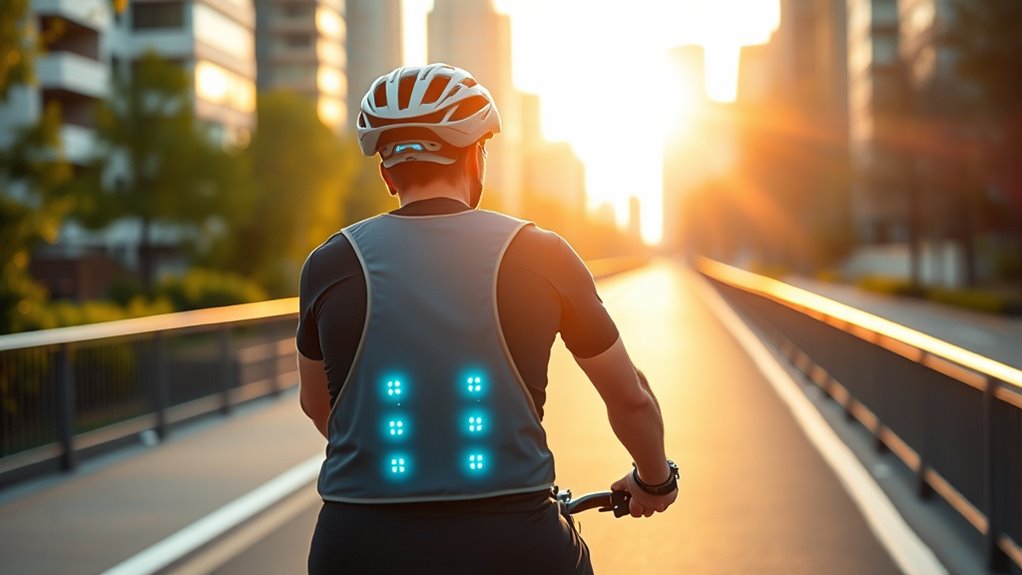
Smart gear can considerably boost your safety on the road. Features like impact sensors and automatic crash alerts in helmets help respond quickly to accidents, while smart lights improve visibility and communication. These accessories work together to make your rides safer, especially in low-light or complex conditions. Additionally, understanding the importance of privacy policy and user consent when using connected devices can help you make informed choices about your data and enhance your overall experience. As AI-driven safety features become more advanced, staying informed about AI security considerations can further protect your personal information during your rides. Moreover, integrating music therapy principles, such as calming sounds or alerts, can also contribute to a more relaxed and attentive cycling experience. Being aware of environmental considerations can encourage eco-friendly riding habits that support sustainability, aligning with the growing trend of cryptocurrency opportunities that promote sustainable investments and practices.
Smart Helmets for Safety
Enhancing safety while cycling has become easier with the advent of smart helmets designed to protect riders in real time. These helmets feature impact sensors that detect crashes and automatically notify emergency contacts, boosting rider safety. Many models include safety features like integrated LED lights and Bluetooth connectivity, enabling you to signal turns and receive alerts effortlessly. Advanced options incorporate cameras for real-time recording, providing vital evidence if needed. Impact detection technology can reduce cycling injuries by up to 25%.
Key benefits include:
- Impact sensors for crash detection and accident prevention
- Integrated LED lights for visibility enhancement
- Bluetooth connectivity for alerts and communication
- Real-time recording for safety documentation
Visibility With Smart Lights
In low-light or challenging visual conditions, smart lights considerably boost your visibility on the road. These smart lights automatically adjust brightness based on ambient light, ensuring you’re always seen during night rides or in poor lighting. They enhance rider safety by alerting other drivers through features like turn signals and brake indicators, acting as effective communication tools. Sensors detect approaching vehicles and cause the lights to flash brighter near intersections, increasing your safety. Many smart bike lights can be controlled via a smartphone app, allowing you to customize modes and activate lighting remotely. Portable options like LED slap bands provide affordable, easy-to-use solutions for improved visibility. With smart lights, you gain reliable, adaptable illumination that keeps you visible and safe in any lighting condition.
Seamlessly Connecting Your Bike to Digital Ecosystems
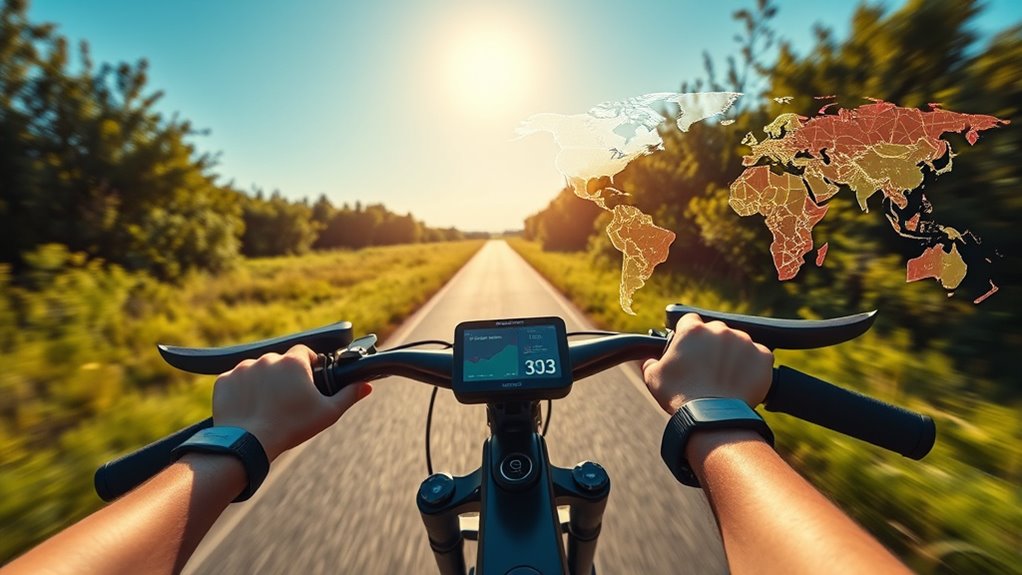
Connecting your bike to digital ecosystems is straightforward when you understand the key protocols like Bluetooth, Wi-Fi, and ANT+. These wireless technologies enable smart bike connectivity, allowing your devices to sync seamlessly. With Bluetooth synchronization, your cycling apps can share real-time data for performance monitoring and ride planning. Compatibility across different devices ensures all your gadgets work together smoothly. You can integrate smart helmets, GPS computers, and fitness trackers for a thorough cycling experience. Here’s what you’ll benefit from:
- Real-time data sharing across devices
- Enhanced performance monitoring
- Improved safety with smart helmet alerts
- Effortless device compatibility across platforms
Advancements in wireless technology make it easier than ever to connect and control multiple smart cycling gadgets, elevating your rides with integrated digital ecosystems.
Customizing Your Ride With Smart Technology Integration
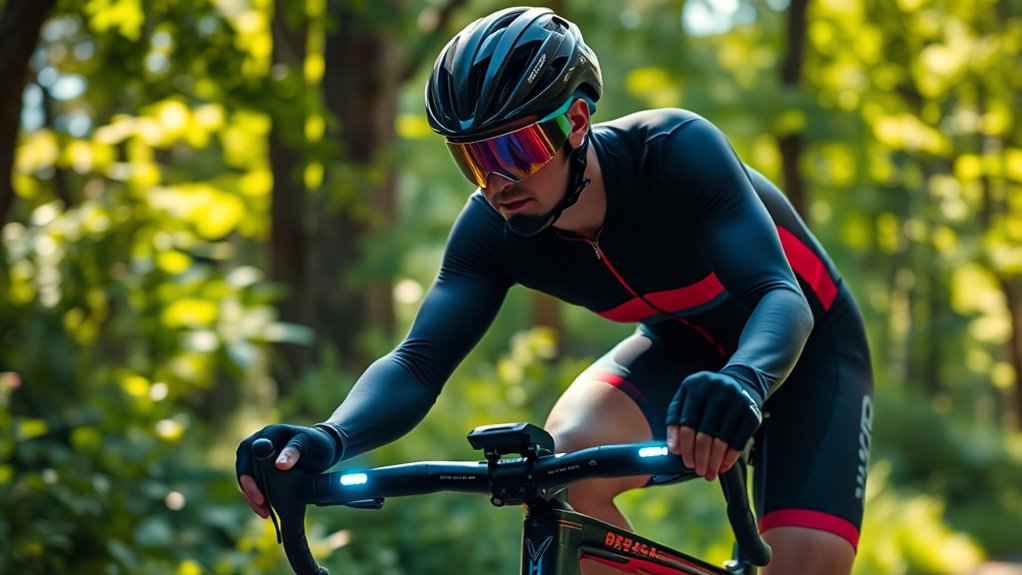
By customizing your ride with smart technology, you can tailor every aspect of your cycling experience to match your unique preferences and goals. With smart accessories and connected devices, you can personalize lighting, safety features, and performance settings to enhance your ride experience. GPS integration and route planning apps help you select terrain that suits your style, while performance monitoring tools like power meters and heart rate sensors provide real-time training data. This data allows you to make data-driven adjustments for better performance optimization. You can also fine-tune motor responses via apps like Mission Control, ensuring your bike adapts to your riding style. Overall, smart technology empowers you to create a highly personalized, efficient, and enjoyable cycling routine through seamless customization.
Monitoring and Improving Your Fitness Metrics

Monitoring and improving your fitness metrics is essential for optimizing your cycling performance. Using smart technology, you can track crucial data such as heart rate, cadence, and power output, giving you clear insights into your training. Real-time data from sensors like power meters and cadence monitors helps refine your cadence and effort during rides. Fitness tracking apps enable detailed data analysis, supporting goal setting and progress tracking. To enhance your training, focus on:
- Heart rate zones and recovery data for personalized workouts
- Monitoring sleep patterns to improve overall recovery
- Analyzing performance metrics over time for targeted improvements
- Using data analysis to identify strengths and weaknesses
Implementing Smart Lighting and Visibility Solutions

Enhancing your visibility during rides is essential for safety, especially in low-light conditions. Smart lighting offers dynamic visibility solutions by automatically adjusting brightness based on ambient light, ensuring you’re seen day or night. These smart lights, easily attached via LED slap bands or handlebar mounts, provide quick installation and removal. Integration with cycling apps via Bluetooth or Wi-Fi allows you to customize lighting modes and control them remotely. Built-in communication features like turn signals, brake indicators, and warning signals improve safety by alerting others to your intentions and detecting approaching vehicles. Sensors can activate brighter flashes or warning signals when needed, increasing safety for you and other road users. Overall, smart lighting enhances visibility and communication, making your rides safer and more efficient.
Securing Your Bicycle With Advanced Smart Locks

Securing your bicycle has become more reliable and convenient with the advent of advanced smart locks. These smart locks enhance bicycle security through features like remote control, allowing you to lock or open your bike via a smartphone app without physical keys. Many models include tamper alarms and instant notifications to alert you if someone tries to interfere with your bike. GPS tracking is integrated into some locks, providing real-time location updates to aid theft prevention and quick recovery. Additional features like auto-locking activate when parked, and open when you approach, boosting cycling safety.
- Control your lock remotely with a smartphone app
- Receive tamper alarms and alerts for unauthorized access
- Use GPS tracking for real-time location monitoring
- Enable auto-locking for seamless security
Staying Ahead: Future Innovations in Cycling Technology

As cycling technology continues to evolve at a rapid pace, future innovations promise to transform how you navigate, stay safe, and optimize your riding experience. Expect AR ride guides to provide real-time directions, making route navigation seamless, while real-time collision detection enhances safety by alerting you to hazards instantly. Smart infrastructure will feature glowing, cyclist-visible lines and roads capable of charging e-bikes, supporting connected cycling. Personalized coaching through physiological sensors will monitor stress levels and recovery, tailoring training to your needs. AI-powered optimization will analyze your cycling performance to suggest improvements and adaptive strategies. These future cycling technologies, combined with innovative accessories, will make your rides smarter, safer, and more enjoyable, pushing the boundaries of what’s possible in cycling.
Frequently Asked Questions
How Does Smart Technology Impact Bike Maintenance and Longevity?
Smart technology greatly impacts bike maintenance and longevity by providing real-time data on your bike’s condition. You can receive alerts for issues like low tire pressure, chain wear, or brake performance, allowing you to address problems early. This proactive approach helps prevent major repairs, extends your bike’s lifespan, and guarantees ideal performance. With regular updates and diagnostics, you keep your bike in top shape, saving money and enjoying safer rides.
Are Smart Cycling Devices Compatible With All Bike Types?
Did you know that over 60% of smart cycling device users report improved riding experience? When it comes to compatibility, smart devices aren’t all universal. Most are designed for standard bikes, but some work with specific models or require adapters. Check the device specs carefully and confirm your bike has the necessary sensors or mounts. With the right setup, you can enjoy smart tech on almost any bike, regardless of type.
What Are the Privacy Concerns With Connected Cycling Gear?
When you use connected cycling gear, privacy concerns arise because these devices collect your location, speed, and health data. You might unknowingly share sensitive information with manufacturers or third parties, risking data breaches or misuse. Always review privacy policies, disable unnecessary tracking, and update your device’s security settings. Staying informed helps you protect your personal information while enjoying the benefits of smart technology on your rides.
How Do Smart Devices Adapt to Different Weather Conditions?
Did you know that 85% of smart devices now automatically adjust to weather changes? When you use smart cycling gear, it detects weather conditions like rain or temperature shifts through sensors and connected apps. You can expect your device to modify settings, such as screen brightness, GPS routing, or alert notifications, ensuring you stay safe and comfortable regardless of the weather. This adaptability helps optimize your ride experience seamlessly.
Can Smart Technology Help Prevent Theft Beyond Locking Mechanisms?
Smart technology can do more than just lock your bike; it can also help prevent theft through GPS tracking and real-time alerts. You’ll receive notifications if your bike moves unexpectedly or if it’s tampered with, allowing you to act quickly. Some devices even have built-in alarms that activate if someone tries to steal your bike. These features give you added security and peace of mind beyond traditional locking mechanisms.
Conclusion
By blending bold, innovative, and intuitive smart technology into your biking routine, you’ll boost your safety, sharpen your skills, and stay ahead of the curve. Embrace the endless extras that enhance efficiency, enjoyment, and security—ensuring every ride is safe, smart, and satisfying. Stay savvy, stay connected, and let technology transform your cycling experience into an extraordinary adventure you’ll always appreciate.
